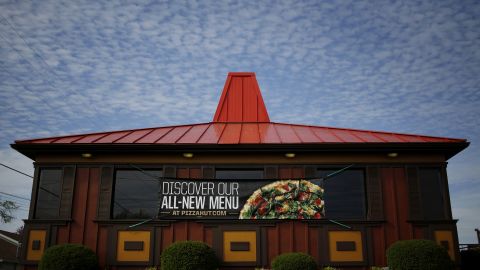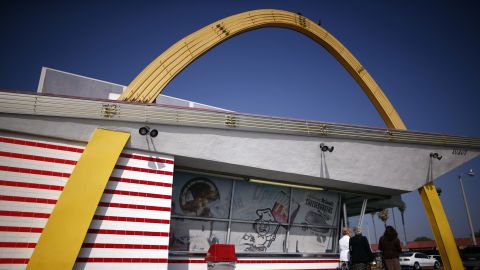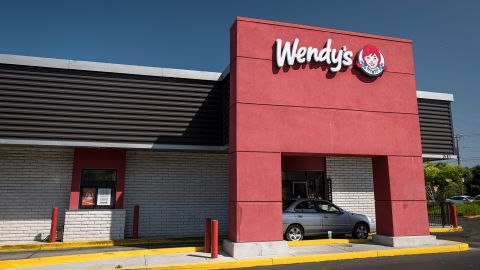Why Pizza Hut’s red roofs and McDonald’s play places have disappeared
New York
CNN Organization
—
For a long time, vivid, playful and oddly-formed quick-food stuff places to eat dotted the roadside alongside America’s highways.
You’d travel by Howard Johnson’s with its orange roofs and then pass Pizza Hut’s crimson-topped huts. A few much more miles and there was the roadside White Castle with its turrets. Arby’s roof was shaped like a wagon and Denny’s resembled a boomerang. And then McDonald’s, with its neon golden arches towering previously mentioned its restaurants.
These quirky patterns had been an early form of model advertising, gimmicks intended to seize drivers’ awareness and get them to quit in.
As rapid-food stuff chains distribute across the US following Earth War II, new roadside restaurant makes essential to stand out. Tv was new media not still beamed into just about every one home, newspapers had been continue to ascendant and social media unimaginable.
So restaurant chains turned to architecture as a vital tool to promote their model and assist create their company id.

But the quickly-foodstuff architecture of nowadays has shed its quirky appeal and distinctive functions. Shifts in the restaurant field, advertising and marketing and know-how have manufactured rapid-foods exteriors bland and spiritless, critics say.
Goodbye vibrant hues and unusual shapes. Nowadays, the structure is nominal and sleek. Most quickly-foods dining establishments are designed to increase effectiveness, not catch motorists’ focus. Quite a few are shaped like boxes, embellished with phony wood paneling, imitation stone or brick exteriors, and flat roofs. Just one critic has referred to as this pattern “faux five-star restaurants” intended to make consumers neglect they are eating greasy fries and burgers.
The chains now sport nearly similar appears to be like. Simply call it the gentrification of fast-food stuff layout.
“They’re soulless small bins,” said Glen Coben, an architect who has developed boutique resorts, places to eat and merchants. “They’re like Monopoly residences.”
Speedy-meals eating places designed and expanded in the mid-twentieth century with the explosion of car lifestyle and the progress of interstate highways.
Huge businesses came to dominate freeway dining places through a method recognized as “place-solution-packaging” – the coordination of making design and style, decor, menu, services and pricing, in accordance to John Jakle, the author of “Fast Food: Roadside Dining places in the Car Age.”
Quick-foodstuff chains’ properties were designed to catch the eye of prospective customers driving by at superior speeds and get them to sluggish down.
“The buildings experienced to be visually robust and bold,” explained Alan Hess, an architecture critic and historian. “That involved neon signals and the form of the developing.”
A major example: McDonald’s style, with its two golden arches sloping around the roof of its restaurant, a design regarded as Googie.

Released in California in 1953, McDonald’s style and design was motivated by extremely-modern day coffee shops and roadside stands of Southern California, then the heart of budding fast-food chains.
The two 25-foot bright yellow sheet-metallic arches that rose by the McDonald’s structures have been tall enough to entice motorists amid the muddle of other roadside properties, their neon trim gleaming day and night time. McDonald’s style and design established off a wave of very similar Googie-type architecture at rapid-food stuff chains nationwide.
Nicely into the 1970s, the patterns had been a outstanding fixture of the American roadside, “imprinting the image of fast-food items generate-in architecture in the preferred consciousness,” Hess wrote in a journal posting.
But there was a backlash to this aesthetic. As the environmental movement made in the 1960s, opposition to the conspicuous Googie type grew. Critics known as it “visual pollution.”
“Critics hated this populist, roadside business California architecture,” Hess said. Googie design and style fell out of vogue in the 1970s as quickly-food type favored darkish colours, brick and mansard roofs.
McDonald’s new prototype became a minimal-profile mansard roof and brick design with shingle texture. Its arches moved from atop the creating to signposts and grew to become McDonald’s company emblem.

“McDonald’s and Jack in the Box unfurled their neon and Working day Glo banners and architectural containers in opposition to the limitless sky,” the New York Situations stated in 1978. They have been “toned down with the transforming style of the 60’s and 70’s.” And with the advancement of mass communications advertising campaigns, makes no extended relied on architectural features to stand out –they could only flood the television airwaves.
In the 1980s and 1990s, businesses started introducing children’s engage in regions and party rooms to draw people – additions to current “brown” structures, Hess reported.
The increase of cell buying and expense fears because then altered contemporary quickly-food design and style.
With much less individuals sitting down for entire meals at speedy-food stuff eating places, providers did not need elaborate dining areas. So currently they are expanding push-through lanes, expanding the range of pickup home windows and including digital kiosks in retailers.

“We have a large amount of crimson-roof restaurants” that “clearly require to go away,” a Pizza Hut government mentioned in 2018 of its typical style. The company’s new prototype, “Hut Lanes,” will help to velocity up hold out situations at travel-via destinations.
The new fast-food stuff box models with their flat roofs are extra effective to warmth and awesome than older buildings, stated John Gordon, a cafe specialist. Kitchens have been reconfigured to speed up food preparation. They’re also less expensive to establish, retain and staff a more compact retail outlet.
But in the work to modernize, some say quick-foodstuff design has became homogenized and lost its artistic objective.
“I do not know if you’d be ready to establish what they ended up if they experienced a diverse name on the entrance,” claimed Addison Del Mastro, an urbanist author who files the history of business landscapes. “There’s almost nothing to engage the wandering imagination.”
